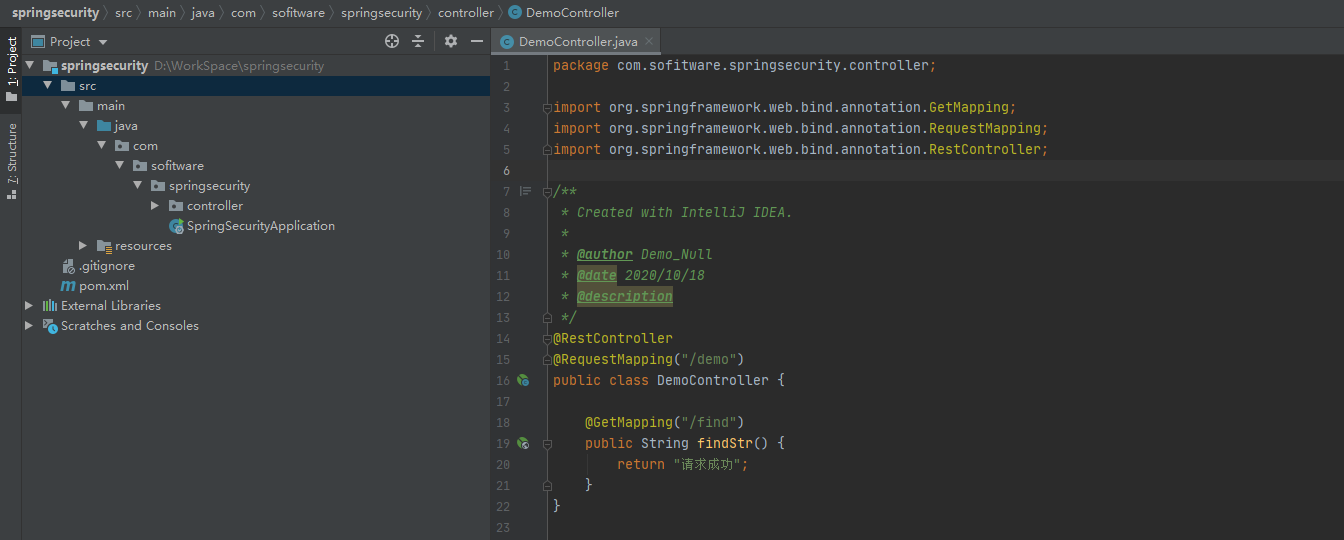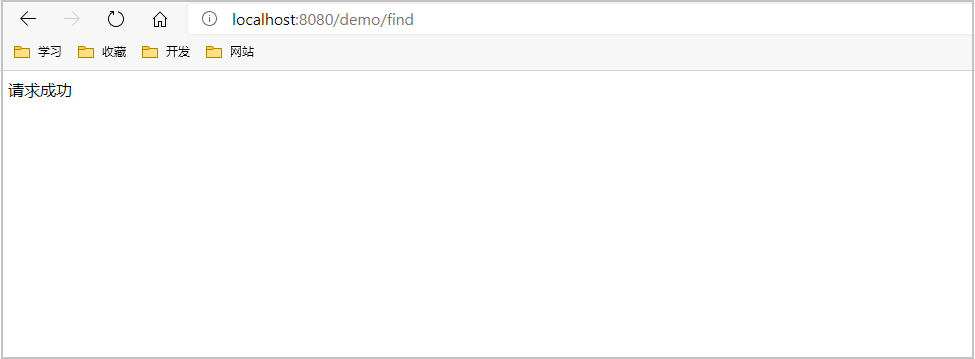Spring Security 在 Spring Boot使用 Spring Security 在 Spring Boot 中的使用详解【集中式】
Demo_Null 人气:01.1 准备
1.1.1 创建 Spring Boot 项目
创建好一个空的 Spring Boot 项目之后,写一个 controller 验证此时是可以直接访问到该控制器的。


1.1.2 引入 Spring Security
在 Spring Boot 中引入 Spring Security 是相当简单的,可以在用脚手架创建项目的时候勾选,也可以创建完毕后在 pom 文件中加入相关依赖。

<dependency> <groupId>org.springframework.boot</groupId> <artifactId>spring-boot-starter-security</artifactId> </dependency>
引入 Spring Security 后再次访问会发现直接被弹到了登录页面,此时我们还什么都没有配置,为什么 Security 会生效呢,这是因为 Spring Boot 帮我们完成了在 Spring 中需要完成的诸多配置【☞Spring Security 基础入门】。也正是因为 Spring Boot 提供了自动化配置方案,让我们可以“零配置”的使用 Spring Security,所以在 Spring Boot 项目中我们通常使用的安全框架是 Spring Security 而在 Spring 中一般使用 Shiro。

我们并没有配置静态的用户那么该如何登录呢,Spring Boot 为我们提供了一个默认的用户,用户名为:user,密码则是在启动 Spring Boot 项目是随机生成的,我们可以在控制台找到他。

1.2 配置认证
1.2.1 添加静态用户
Spring Boot 除了一些信息写道 yml 配置文件中,其他配置都使用配置类,Spring Security 需要继承 WebSecurityConfigurerAdapter,配置用户信息需要重写 configure(AuthenticationManagerBuilder auth) 方法。配置完毕后,将不会再使用 user 用户。
/**
* Created with IntelliJ IDEA.
*
* @author Demo_Null
* @date 2020/10/18
* @description Spring Security 配置类
*/
@Configuration
@EnableWebSecurity
public class SecurityConfig extends WebSecurityConfigurerAdapter {
@Override
protected void configure(AuthenticationManagerBuilder auth) throws Exception {
// 配置静态用户
auth.inMemoryAuthentication()
.withUser("admin")
.password("{noop}123") // 此处需要加 {noop} 表示该密码为明文
.roles("USER");
}
}
1.2.2 添加数据库认证 ☞ 添加用户实体类
Spring Security 中使用的用户是 UserDetails,我们要么让自定义用户类实现 UserDetails,要么使用时将自定义用户类转换为 UserDetails。建议实现 UserDetails。因为该类中涉及到角色信息所以我们还需要创建角色类。我们在以后的操作中可能会将对象转为 json 或者将 json 转为对象,所以我们重写的方法需要加上 @JsonIgnore 将其忽略(该类本来就需要的不用忽略)。
/**
* Created with IntelliJ IDEA.
*
* @author gaohu9712@163.com
* @date 2020/10/18
* @description 用户实体类
*/
public class SysUser implements UserDetails {
private Long id;
private String username;
private String passwrod;
private List<SysRole> roleList = new ArrayList<>();
public Long getId() {
return id;
}
public void setId(Long id) {
this.id = id;
}
public void setUsername(String username) {
this.username = username;
}
public void setPasswrod(String passwrod) {
this.passwrod = passwrod;
}
public List<SysRole> getRoleList() {
return roleList;
}
public void setRoleList(List<SysRole> roleList) {
this.roleList = roleList;
}
@Override
public Collection<? extends GrantedAuthority> getAuthorities() {
return roleList;
}
@Override
public String getPassword() {
return passwrod;
}
@Override
public String getUsername() {
return username;
}
@Override
@JsonIgnore
public boolean isAccountNonExpired() {
return false;
}
@Override
@JsonIgnore
public boolean isAccountNonLocked() {
return false;
}
@Override
@JsonIgnore
public boolean isCredentialsNonExpired() {
return false;
}
@Override
@JsonIgnore
public boolean isEnabled() {
return false;
}
}
☞ 创建角色类
Spring Security 中使用的角色信息使用的是 GrantedAuthority 所以我们的角色类也需要实现 GrantedAuthority。
/**
* Created with IntelliJ IDEA.
*
* @author Demo_Null
* @date 2020/10/18
* @description 角色类
*/
public class SysRole implements GrantedAuthority {
private Long id;
private String roleName;
private String roleDesc;
public Long getId() {
return id;
}
public void setId(Long id) {
this.id = id;
}
public String getRoleName() {
return roleName;
}
public void setRoleName(String roleName) {
this.roleName = roleName;
}
public String getRoleDesc() {
return roleDesc;
}
public void setRoleDesc(String roleDesc) {
this.roleDesc = roleDesc;
}
@Override
@JsonIgnore
public String getAuthority() {
return roleName;
}
}
☞ 添加持久层
此处省略使用通用 mapper 操作数据库的内容【☞ Mybatis 使用通用 mapper】,jpa 等其他操作数据库的方法亦可。
☞ 认证类
Spring Boot 中 Spring Security 的认证类与 Spring 中的并无区别,都需要实现 UserDetailsService 接口,然后重写 loadUserByUsername(String s) 方法并返回一个 UserDetails。
/**
* Created with IntelliJ IDEA.
*
* @author Demo_Null
* @date 2020/10/18
* @description 认证类
*/
public class UserDetailsServiceImpl implements UserDetailsService {
@Autowired
private UserMapper userMapper;
@Override
public UserDetails loadUserByUsername(String s) throws UsernameNotFoundException {
return userMapper.findByName(s);
}
}
☞ 配置类
/**
* Created with IntelliJ IDEA.
*
* @author Demo_Null
* @date 2020/10/18
* @description Spring Security 配置类
*/
@Configuration
@EnableWebSecurity
public class SecurityConfig extends WebSecurityConfigurerAdapter {
@Autowired
private UserDetailsService userDetailsService;
@Bean
// BCrypt 交由 Ioc 容器管理
public BCryptPasswordEncoder passwordEncoder() {
return new BCryptPasswordEncoder();
}
@Override
protected void configure(AuthenticationManagerBuilder auth) throws Exception {
// 认证类
auth.userDetailsService(userDetailsService).passwordEncoder(passwordEncoder());
}
}
1.3 授权
1.3.1 开启方法级授权
在启动类上使用 @EnableGlobalMethodSecurity 注解开启方法级授权。参数 prePostEnabled 代表 Spring 中的权限控制注解;securedEnabled 代表 Spring Security 中的权限控制注解; jsr250Enabled 代表 jsr250 的权限控制注解
。
@SpringBootApplication
@MapperScan("com.software.springsecurity.mapper")
@EnableGlobalMethodSecurity(securedEnabled = true)
public class SpringSecurityApplication {
public static void main(String[] args) {
SpringApplication.run(SpringSecurityApplication.class, args);
}
}
1.3.2 添加方法权限
当用户仅有 ROLE_USER 权限时仅能访问 findStr 方法而不能访问 get 方法;要想访问 get 方法用户必须具有 ROLE_ADMIN 权限。
/**
* Created with IntelliJ IDEA.
*
* @author Demo_Null
* @date 2020/10/18
* @description
*/
@RestController
@RequestMapping("/demo")
public class DemoController {
@GetMapping("/find")
@Secured("ROLE_USER")
public String findStr() {
return "请求成功";
}
@GetMapping("/get")
@Secured("ROLE_ADMIN")
public String get() {
return "get";
}
}


1.3.3 异常拦截页面
@ControllerAdvice
public class HandlerControllerAdvice {
@ExceptionHandler(AccessDeniedException.class)
public String handlerException(){
return "redirect:/403.html";
}
@ExceptionHandler(RuntimeException.class)
public String runtimeHandlerException(){
return "redirect:/500.html";
}
}
总结
加载全部内容